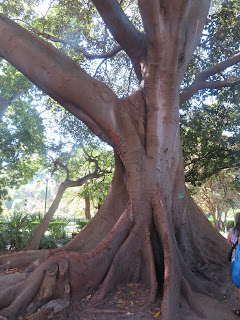Day 82 Thur Apr 6 Cape Town, South Africa depart 4:00
I went on an adventure today. I walked to the Hop on-Hop off Red Bus base near me and found out what I was told yesterday wasn’t exactly true. I would need to buy an all day pass to get a ride to the Hop on-Hop off Headquarters where a walking tour would begin. The girl finally said, take a taxi if you can’t ride the Hop on-Hop Off bus all day. I walked down the street looking for a taxi and found an Uber. It cost me $3. to get to Hop on-Hop off headquarters. I waited until 10:00 for the tour to start. We needed to make a choice between the historic section or the colorful houses. I chose the historic section.
My guide was okay. He spoke loudly enough and his English was great as the people in Cape Town learn English. We went to the 300+ year old Greenmarket Square which had a market happening. This square has been the setting of important events throughout history since 1696, many pertaining to apartheid. There were many historical buildings surrounding that square. One of them was the original newspaper building and the coffee company there today had their lobby decorated with replicas of the front page of important events from history of Cape Town and elsewhere.
At the end of the street is a creative structure connecting Mandela (who worked in the Parliament) with Desmond Tutu of St. George’s Cathedral. The preamble to the South African constitution is engraved in bronze markers on the ground. Pictured below.
The Iziko Slave Lodge Museum is one of the oldest buildings in Cape Town. It’s current focus is ‘From human wrongs to human rights’. Seven to nine thousand men, women and children suffered gross human injustice over a time span of 132 years. The building is a living memorial. It has also been government offices and the Supreme Court Building.
We went into the Company’s Garden and saw Moreton Bay Fig tree, a memorial fountain to honor Howson Edwards Rutherfoord, Esq., a pear tree said to be 250 years old, a statue of Cecil Rhodes who managed diamond mines, was involved in politics and was prime minister of Cape Colony. We also saw Tuynhuys Office of the President. The Parliament Building is next door, it was recently damaged by fire. The South African National Library is across the street.
Tuynhuys Office of the President.
Groote Kirk is next door and is a well-known building in Cape Town. It was the first Christian church built in the Cape. The old tower remains from the original building. There have been many alterations and remodeling over the years.
I tried to understand Apartheid today. It is much more complicated than I realized. I did not realize how Apartheid sorted people into categories utilizing the Population Registration Act, 1950. People were classified into four racial groups based on appearance, known ancestry, socioeconomic status and cultural lifestyle. The classifications were Black, White, Coloured and Indian. Between 1960 and 1983, 3.5 million black Africans were removed from their homes and forced into segregated neighborhoods. Sometimes families were split up because a white man may have had children with a black woman, there were rules that kept them apart and depending on the appearance of the children it determined where they could live.













No comments:
Post a Comment